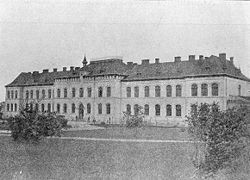
Agricultural Academy in Dublany
Encyclopedia

Dubliany
Dubliany is a town in Lviv Oblast of Ukraine. Population is 8,469 . In the early 20th century, it was famous as the seat of the Agricultural Academy.- External links : in the Geographical Dictionary of the Kingdom of Poland...
was one of the first Polish language
Polish language
Polish is a language of the Lechitic subgroup of West Slavic languages, used throughout Poland and by Polish minorities in other countries...
schools of this kind. Its history dates back to 1852, when a farm in the village of Dublany (eight kilometers from the outskirts of Lwow, currently in Ukraine
Ukraine
Ukraine is a country in Eastern Europe. It has an area of 603,628 km², making it the second largest contiguous country on the European continent, after Russia...
) was purchased by the Galicia
Kingdom of Galicia and Lodomeria
The Kingdom of Galicia and Lodomeria was a crownland of the Habsburg Monarchy, the Austrian Empire, and Austria–Hungary from 1772 to 1918 .This historical region in eastern Central Europe is currently divided between Poland and Ukraine...
Agricultural Society. Four years later, a private School of Village Agriculture was opened there and in 1858, the school was turned into the Agricultural College, with Leon Sapieha
Leon Sapieha
Leon Sapieha was a Polish noble , politician and statesman.Leon was born and educated in Warsaw, and studied law and economic in Paris and Edinburgh from 1820 to 1824. He began to work in the administration in the Polish Kingdom...
being the founder. In 1901 the school gained the rights of a university and was financed by the Galician authorities. However, it never received permission to issue doctorate degree, issuing only the agronomist
Agronomist
An agronomist is a scientist who specializes in agronomy, which is the science of utilizing plants for food, fuel, feed, and fiber. An agronomist is an expert in agricultural and allied sciences, with the exception veterinary sciences.Agronomists deal with interactions between plants, soils, and...
diplomas.
During the Polish-Ukrainian War
Polish-Ukrainian War
The Polish–Ukrainian War of 1918 and 1919 was a conflict between the forces of the Second Polish Republic and West Ukrainian People's Republic for the control over Eastern Galicia after the dissolution of Austria-Hungary.-Background:...
, the Academy’s campus was destroyed and as a result, it was moved to Lwow, where in 1919 it was merged with the Lviv Polytechnic
Lviv Polytechnic
Lviv Polytechnic National University is the largest scientific university in Lviv. Since its foundation in 1844, it was one of the most important centres of science and technological development in Central Europe. In the interbellum period, the Polytechnic was one of the most important technical...
, creating Agricultural and Forestry Department.
At the beginning of the 20th century, the campus consisted of two buildings, the main one constructed in 1888 and the laboratory complex, opened in 1900. Before World War I
World War I
World War I , which was predominantly called the World War or the Great War from its occurrence until 1939, and the First World War or World War I thereafter, was a major war centred in Europe that began on 28 July 1914 and lasted until 11 November 1918...
, it had around 1500 students, most of them from Congress Poland
Congress Poland
The Kingdom of Poland , informally known as Congress Poland , created in 1815 by the Congress of Vienna, was a personal union of the Russian parcel of Poland with the Russian Empire...
. Among its professors, there were such names as Stefan Dab-Biernacki
Stefan Dab-Biernacki
Stefan Dąb-Biernacki was a Polish general.Members of the Polish Legions in World War I, fought in the Polish-Soviet War commanding regiments and later 1DPLeg...
, Juliusz Au and Wladyslaw Tyniecki. Most famous graduates include Stefan Alexandrowicz, Adam Brzechwa-Ajdukiewicz and Wlodzimierz Puchalski
Wlodzimierz Puchalski
Włodzimierz Puchalski was a Polish photographer and film director.-Life:He was born in Mostki Wielkie, near Lwów . Puchalski studied at the Politechnika Lwowska to become an agronomic engineer...
.

